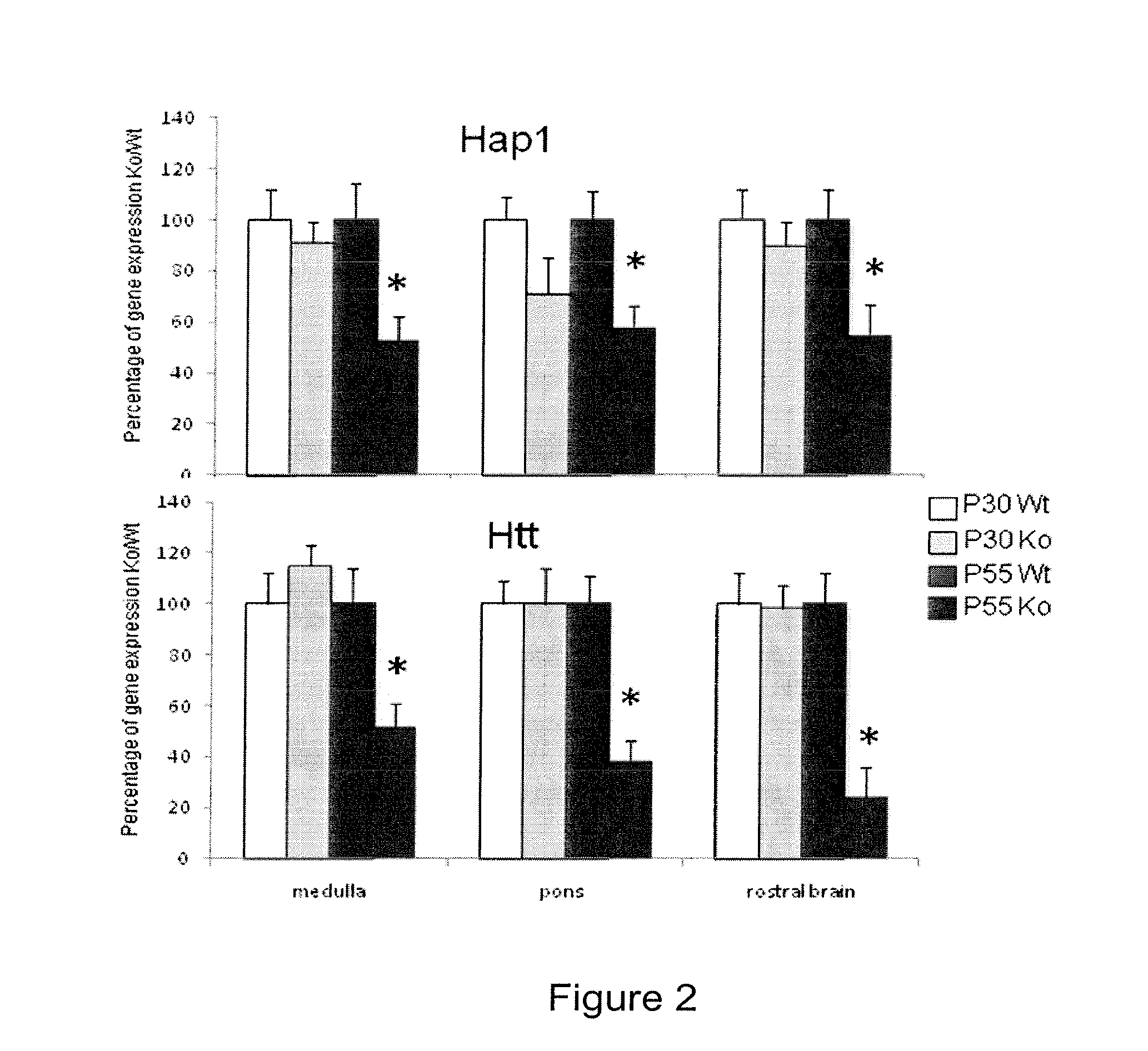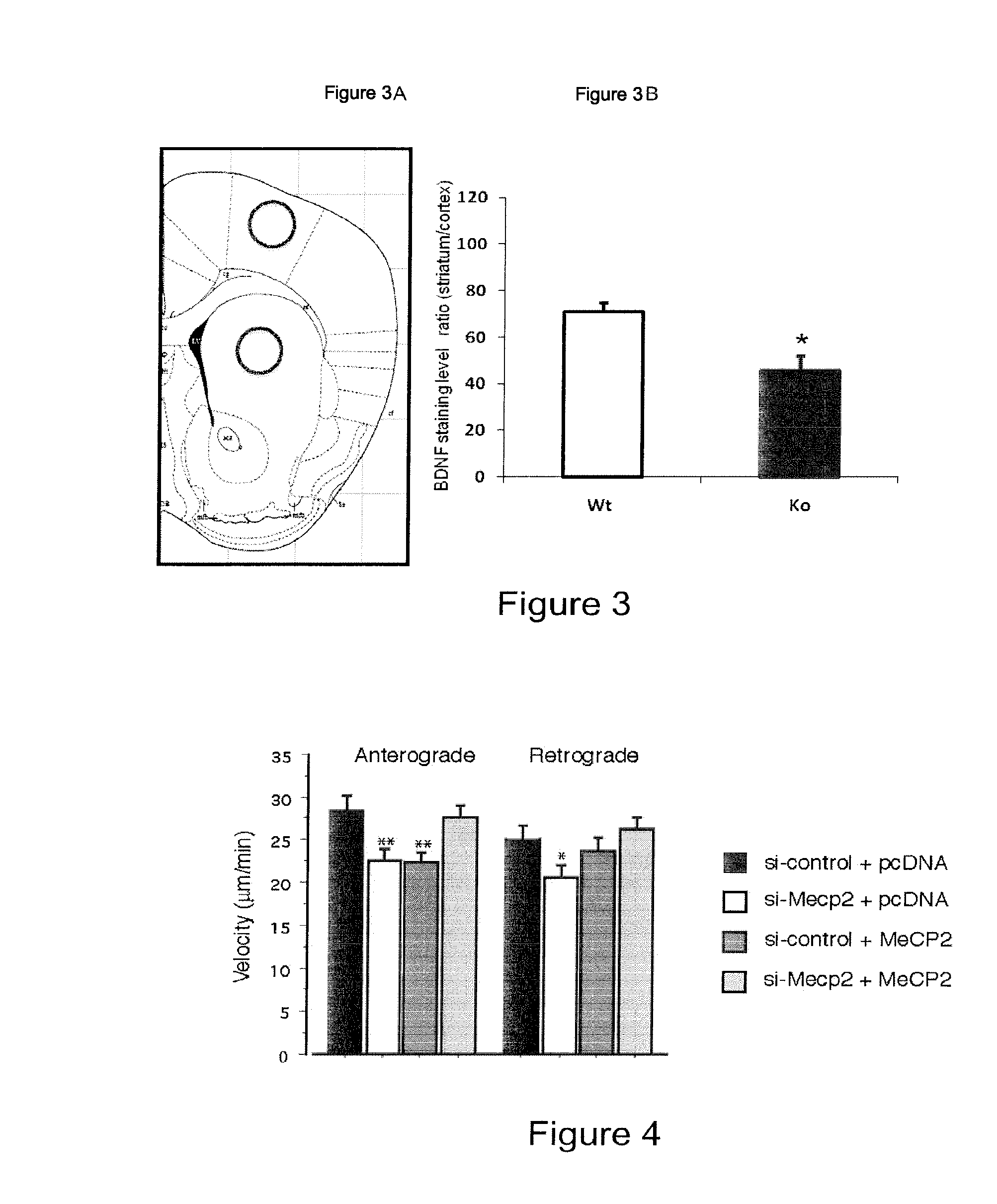Treatment of MeCP-2 Associated Disorders
a mecp2-associated disorder and disease technology, applied in the field of compounds, can solve the problems of affecting affecting the development of repetitive hand movements, and affecting the use of purposeful hand use and any acquired language skills, and achieve the effect of prolonging the lifespan of mecp2-deficient mi
- Summary
- Abstract
- Description
- Claims
- Application Information
AI Technical Summary
Benefits of technology
Problems solved by technology
Method used
Image
Examples
example 1
Transcriptional Profiling in the Medulla Oblongata of MeCP2-Deficient Mice Showed Abnormal Expression of a Number of Genes Involved in Bdnf Trafficking
[0076]The inventors have analysed mRNA expression patterns in symptomatic P55 MeCP2-deficient (Ko) (n=6) and wild type mice (Wt) (n=6) medulla oblongata using DNA microarrays. Each sample was hybridized independently and using dye swap. They have found 12 genes to be deregulated in all MeCP2-deficient samples (table 1). To confirm the microarray findings, they have used new MeCP2-deficient medulla oblongata samples (n=3) to measure transcript levels using real-time quantitative PCR. The expression of 10 of the 12 genes was confirmed to be deregulated in the medulla oblongata of all MeCP2-deficient mice tested. These ten genes included two known to play an active role in neuronal transport of Bdnf by huntingtin-associated protein 1 (Hap1) and serum / glucocorticoid-regulated kinase 1 (Sgk1). Real-time PCR experiments found a 35% reductio...
example 2
Underexpression of Genes Involved in Bdnf Trafficking in the Whole Brain of MeCP2-Deficient Mice
[0077]To determine if the findings made analyzing the medulla oblongata could be extended to other regions of the MeCP2-deficient brain, the inventors have tested new samples to see whether Hap1, Sgk1 and Itpr1 transcripts were abnormally expressed in different regions of the brain at P55. Using real-time quantitative PCR on dissected brain areas, they have found Hap1 to be significantly downregulated in the medulla oblongata (−47%, n=5) and also in the pons (−42%, n=4) and the rostral brain (−45%, n=4) of MeCP2-deficient mice (FIG. 1). The inventors have confirmed that Sgk1 was downregulated in the medulla oblongata (−50%, n=5) and observed a downregulation in the pons (−37%, n=5). The have found a significant upregulation in the rostral brain (+44%, n=4). They have also confirmed that Itpr1 was upregulated in the medulla oblongata (+110%, n=5), the pons (+150%, n=5) and the rostral brai...
example 3
[0078]Absence of MeCP2 Causes Gradual Postnatal Underexpression of Htt and Hap1 Throughout the Brain.
[0079]MeCP2-deficient mice are normal until one month of age when they start to gradually develop motor and cognitive dysfunction (Guy, J., Hendrich, B., Holmes, M., Martin, J. E., Bird, A. (2001) A mouse Mecp2-null mutation causes neurological symptoms that mimic Rett syndrome. Nat. Genet. 27, 322-326). The inventors have hypothesized that the progressive neurological dysfunction observed in MeCP2-deficient mice might be caused by progressive postnatal alteration of Hap1 and Htt expression, which, in turn, induces progressive alteration of Bdnf trafficking and the associated neurological abnormalities. They have used new MeCP2-deficient brain samples (n=4 in both experimental and control groups) collected at P30, before the appearance of the first phenotypic manifestations. Using real-time quantitative PCR, they have measured Hap1 and Htt mRNA levels in the medulla oblongata, pons, ...
PUM
| Property | Measurement | Unit |
|---|---|---|
| Optical density | aaaaa | aaaaa |
| temperature | aaaaa | aaaaa |
| neurodevelopmental disorder | aaaaa | aaaaa |
Abstract
Description
Claims
Application Information
 Login to View More
Login to View More - R&D
- Intellectual Property
- Life Sciences
- Materials
- Tech Scout
- Unparalleled Data Quality
- Higher Quality Content
- 60% Fewer Hallucinations
Browse by: Latest US Patents, China's latest patents, Technical Efficacy Thesaurus, Application Domain, Technology Topic, Popular Technical Reports.
© 2025 PatSnap. All rights reserved.Legal|Privacy policy|Modern Slavery Act Transparency Statement|Sitemap|About US| Contact US: help@patsnap.com



